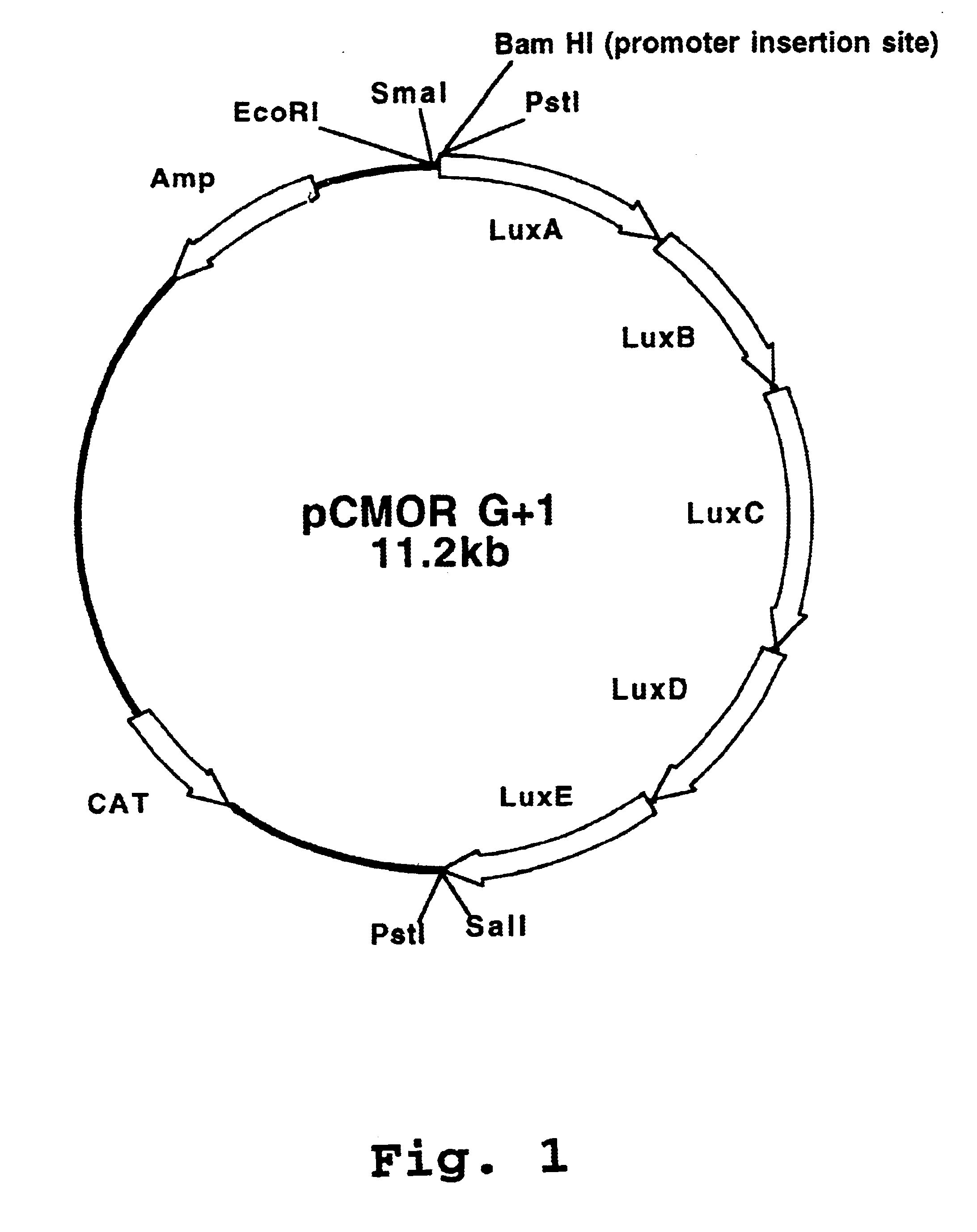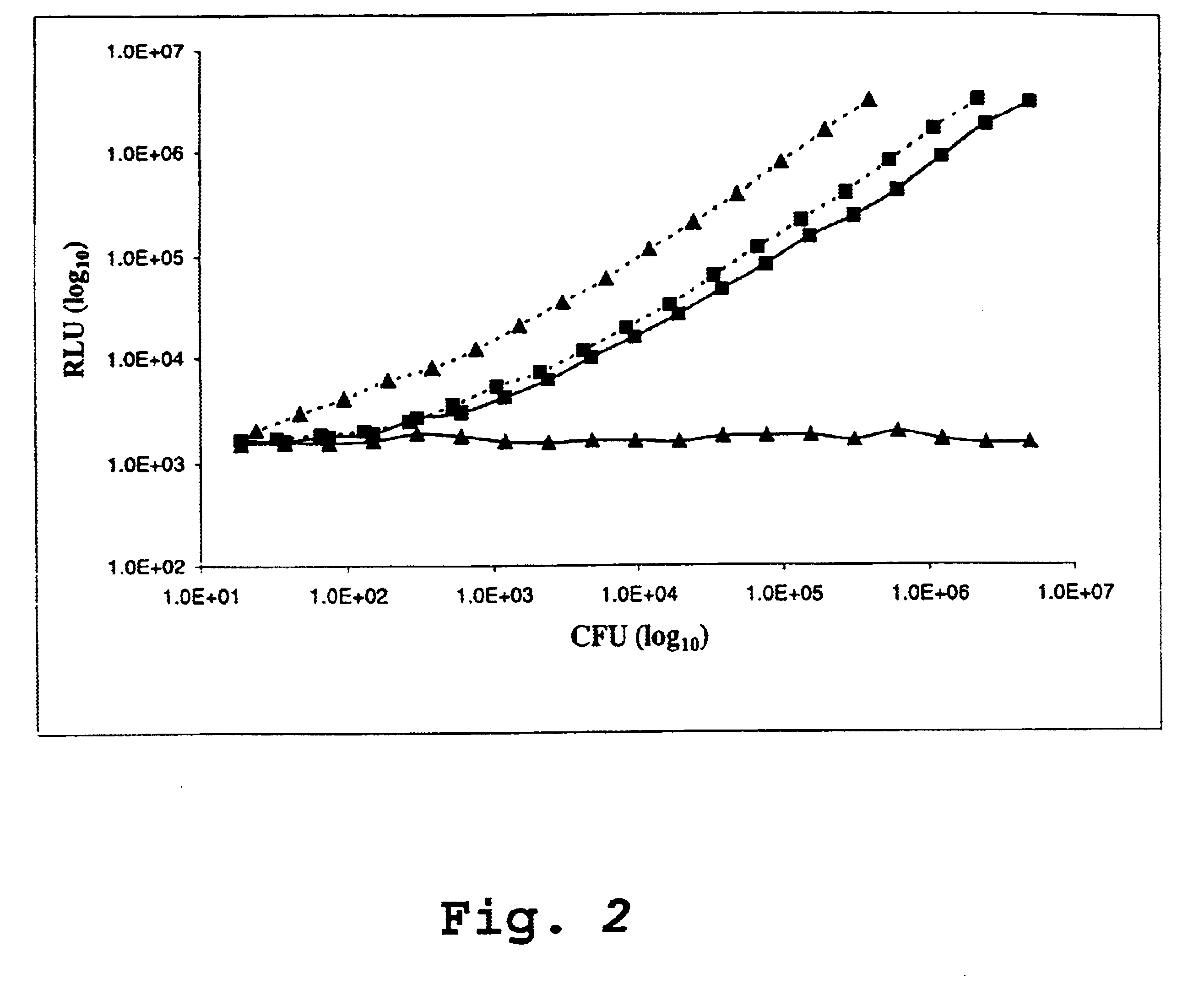Luciferase expression cassettes and methods of use
a technology of luciferase and cassettes, applied in chemical methods analysis, instruments, enzymology, etc., can solve the problems of limited use of luxab constructs for studying pathogenicity and limited transformation of gram-positive bacteria to bioluminescent phenotype, so as to achieve the effect of ensuring cell survival and ensuring cell survival
- Summary
- Abstract
- Description
- Claims
- Application Information
AI Technical Summary
Benefits of technology
Problems solved by technology
Method used
Image
Examples
example 1
Incorporation of Gram-positive RBS Upstream of LuxA, B, C, D and E.
The five genes of the Photorhabdus luminescens lux operon, lux A-E, were PCR amplified using the polymerase chain reaction (PCR; Mullins; Mullins, et al.) to incorporate the sequence of the Gram-positive ribosome binding site (RBS) AGGAGG (SEQ ID NO:1) such that this site was at least seven nucleotides upstream of each start codon. Each of the lux genes was amplified individually using the primer sets shown in Table 1, below. In each case, nucleotides highlighted in bold show the position and sequence of the different restriction endonucleotides (identified in far-right column) incorporated to facilitate cloning. Gram-positive RBSs and start codons are underscored by solid and broken lines, respectively.
PCR was performed with an automated thermocycler (Techne Progene, Princeton, N.J.) with 200 .mu.l thin walled PCR tubes (Molecular BioProducts, San Diego, Calif.). Reactions were carried out in 50 .mu.l volumes contai...
example 2
Construction of pSK.sup.- G+LuxAG+LuxB (LuxAB Cassette in pBluescript)
The genes amplified in Example 1, above, were individually assembled on pBluescript SK.sup.- vectors (Stratagene, LaJolla, Calif.). The luxA PCR product was digested with BamH I / Sal I and ligated into pBluescript SK.sup.- at the BamH I / Sal I sites (directionally orientated downstream of the IPTG-inducible lacZ promoter), generating plasmid pSK.sup.- G+luxA. Plasmid pSK.sup.- G+luxA was then electroporated into DH5.alpha. E. coli (Stratagene), and the cells were plated on LB agar plates containing 100 .mu.g / ml ampicillin. Selected colonies were grown up for plasmid preps, and the plasmid DNA was isolated and cut with Sal I. The resulting fragments were ligated with Sal I / Xho I-cut luxB PCR amplified DNA (Example 1) to generate pSK.sup.- G+luxAG+luxB.
pSK.sup.- G+luxAG+luxB was electroporated into DH5.alpha. E. coli cells, plated on LB agar containing 100 .mu.g / ml ampicillin and the resulting transformants screened f...
example 3
Construction of pSK.sup.- LuxABCDE (LuxABCDE Cassette in pBluescript)
Assembly of a separate luxCDE cassette in pBluescript SK.sup.- was achieved by the sequential cloning of luxC, luxD and luxE essentially as described in Example 2 for the generation of the luxAB cassette. The luxC-E PCR amplification products were individually digested with the compatible enzymes SalI and XhoI, and each step of the cloning procedure was confirmed by PCR of the E. coli transformants. The fidelity of the final luxCDE cassette was confirmed by inserting this sequence, cut with Sal I / Xho I, at the Sal I site downstream of the luxAB genes in pSK.sup.-G+luxAG+luxB, generating pSK.sup.- luxABCDE. Screening was performed as described above, except that no aldehyde treatment was performed, since the substrate was encoded by the luxCDE genes. As above, E. coli DH5.alpha. containing pSK.sup.- luxABCDE were considerably brighter than bacteria containing the native Photorhabdus luminescens lux operon.
PUM
| Property | Measurement | Unit |
|---|---|---|
| wavelength | aaaaa | aaaaa |
| temperatures | aaaaa | aaaaa |
| temperature | aaaaa | aaaaa |
Abstract
Description
Claims
Application Information
 Login to View More
Login to View More - R&D
- Intellectual Property
- Life Sciences
- Materials
- Tech Scout
- Unparalleled Data Quality
- Higher Quality Content
- 60% Fewer Hallucinations
Browse by: Latest US Patents, China's latest patents, Technical Efficacy Thesaurus, Application Domain, Technology Topic, Popular Technical Reports.
© 2025 PatSnap. All rights reserved.Legal|Privacy policy|Modern Slavery Act Transparency Statement|Sitemap|About US| Contact US: help@patsnap.com



